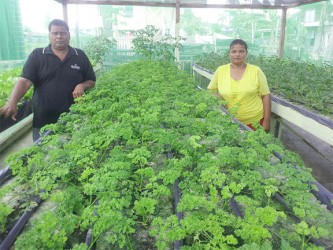Although recent flooding has wreaked havoc on some farms, for Ramdatt and Marlene Persaud all was not lost because of a new greenhouse project that they undertook.
When their farm at L’ Esperance, Canal Number 1, West Bank Demerara was flooded, most of their produce was already harvested except for some cabbages. They lost an entire harvest estimated at over $100,000. However, celery, lettuce, tomatoes, pak choi and eschallot that they planted in a greenhouse and on table tops were spared.
The greenhouse was set up at the couple’s farm as part of the Canal Polders Green Initiative—a joint initiative of the Ministry of Local Government and Regional Development and the Canada-funded Carib-bean Local Economic Deve-lopment (CARILED) programme. The US$41,500 project aims to teach new techniques in farming and to serve as a way to diversify agriculture in Guyana and its primary target is women. In total, three greenhouses were built at farms in Canal Number 1 and Canal Number 2. Two Greenhouses were built at Clay Brick Road, at Canal Number 2.
Ramdatt, 50, said his current goal is to turn his entire farm into a greenhouse. He said the cost may be a bit high, but the crop turnover is so rapid that he sees good financial benefits in the long run.
In addition, he said the experience of growing produce in such a controlled environment is a welcome relief because the plants can be easily monitored and the harvesting time is twice as fast when compared to traditional planting.
Ramdatt and Marlene have been married for 30 years and have been providing for themselves throughout their union. Ramdatt was born into a farming life and it is the only he thing he does to earn a living. The man said the ability to produce one’s own food and supply others as well is a gratifying feeling. Gardening is a skill and he takes great pride in it, he further said.

Ramdatt is also proud of himself for keeping at something he loves and enduring all of the hardships that he has encountered. He recalled losing all of his produce in the Great Flood of 2005. He said this was the only time he ever had to seek another occupation but it was back to normal once the floodwater receded.
Currently, the couple farm both vegetables and citrus fruits. They said their 30-year partnership is enduring because they have an understanding of each other’s role when it comes to their relationship as well as their farming. As one might expect, Ramdatt does most of the manual labour with little to no help. He prefers to work alone because he is very meticulous with the way his fruits and vegetables are planted and harvested. His wife, meanwhile, would usually sell at the Stabroek Market every Friday and her produce is a favourite of shoppers.
The greenhouses were officially commissioned on Monday and according to a Government Information Agency (GINA) report, Minister Norman Whittaker said at the commissioning that the project allows farmers to farm under conditions of pest and disaster control and will eventually replace the traditional method of farming.
He also said that the project is timely because it comes at a time when Guyana is in the process of implementing its Low Carbon Development Strategy in the face of challenges such as climate change and global warming.
He added that while Guyana’s focus has always been on the traditional crops, rice and sugar, government is putting emphasis on diversification. “Government has determined that it is not wise to put all of our resources into one basket. We want to put our resources into other areas, like peas, and pumpkin…we did take off on some projects and were faced with a number of challenges,” he pointed out.
So far, over 35 farmers have benefitted from training sessions in greenhouse technology under the project.
GINA noted that Guyana was one of seven Caribbean countries chosen for the implementation of the CARILED programme, which was launched in May 2012. The six-year programme, funded by the Canadian Department of Foreign Affairs, Trade and Development, is being implemented in regions 2, 3, 4 and 6 and targets the development of business-friendly environments in which micro-small and medium-sized enterprises can prosper. (Rae Wiltshire)





